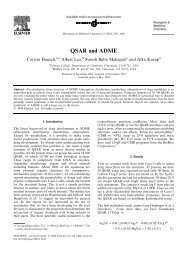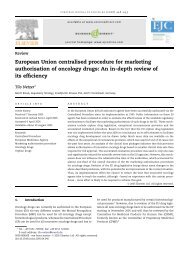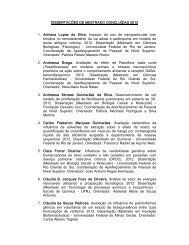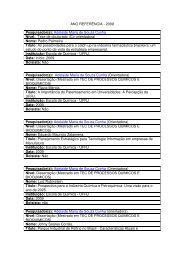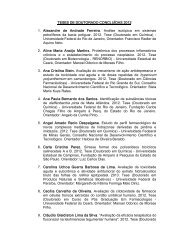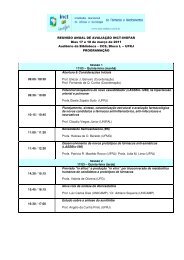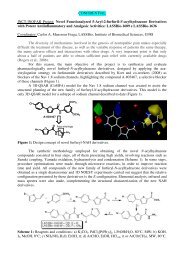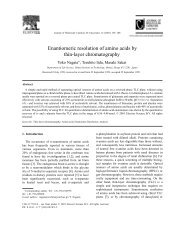Microwave-assisted synthesis and structureâactivity relationships of ...
Microwave-assisted synthesis and structureâactivity relationships of ...
Microwave-assisted synthesis and structureâactivity relationships of ...
Create successful ePaper yourself
Turn your PDF publications into a flip-book with our unique Google optimized e-Paper software.
N. M. Nascimento-Júnior et al. / Bioorg. Med. Chem. Lett. 20 (2010) 74–77 75<br />
Figure 1. Design concept <strong>of</strong> pyrazolo[3,4-b]pyrrolo[3,4-d]pyridine derivatives <strong>of</strong> series A (1), B (4), <strong>and</strong> their simplified analogues (5) <strong>and</strong> (3a).<br />
Scheme 2. Synthesis <strong>of</strong> the functionalized N-phenyl maleimides (3a–3f) <strong>and</strong> N-<br />
phenyl azaphthlimide (5).<br />
Alternatively, the use <strong>of</strong> microwave irradiation under solventfree<br />
conditions has proved to dramatically improve the process<br />
for obtaining new heterocyclic scaffolds exploiting Diels–Alder<br />
reaction as the key-step. 5<br />
Considering this panorama, we described herein the optimization<br />
<strong>of</strong> the synthetic route to obtain the pyrazolo[3,4-b]pyrrolo[3,4-d]pyridine<br />
derivative (1a) <strong>and</strong> some previously described<br />
analogues (1b–1d) using microwave-<strong>assisted</strong> <strong>synthesis</strong> for the hetero<br />
Diels–Alder step under solvent-free conditions. Thus, we propose<br />
the enlargement <strong>of</strong> the congeneric series by the<br />
introduction <strong>of</strong> the isosteric carboxyl group <strong>and</strong> the electrondonating<br />
methoxy substituent at the W position (series A, Fig. 1).<br />
Moreover, we exploited the developed methodology to synthesize<br />
a new series <strong>of</strong> simplified heterocyclic analogues (4a–4f) designed<br />
by changing the pyrazole-attached N-phenyl by a N-<br />
methyl group in order to investigate the stereoelectronic <strong>and</strong> the<br />
lipophilic influences at this position on the sedative pr<strong>of</strong>ile <strong>of</strong> pyrazolo[3,4-b]pyrrolo[3,4-d]pyridine<br />
derivatives (Fig. 1).<br />
On the other h<strong>and</strong>, the exploitation <strong>of</strong> successive molecular<br />
simplifications on the structure <strong>of</strong> sedative prototype (1a) led us<br />
to the design <strong>of</strong> the 3-pyridinylphthalimide (5) <strong>and</strong> 4-nitrophenylmaleimide<br />
(3a) derivatives, as a result <strong>of</strong> the suppression<br />
<strong>of</strong> the pyrazole <strong>and</strong> the pyridine rings (Fig. 1). The comparative<br />
evaluation <strong>of</strong> the sedative pr<strong>of</strong>ile displayed by these heterocyclic<br />
derivatives on the locomotor activity in mice 8 provided a better<br />
underst<strong>and</strong>ing <strong>of</strong> structure–activity <strong>relationships</strong> associated with<br />
their CNS actions.<br />
Initially, the six functionalized N-phenylmaleimides (3a–3f)<br />
were prepared starting from maleic anhydride (6) <strong>and</strong> the corresponding<br />
para-substituted anilines (7).<br />
In order to obtain the desired N-phenylmaleimides (3), the different<br />
behavior <strong>of</strong> this reaction, determined by distinct solubility<br />
<strong>and</strong> nucleophilicity <strong>of</strong> the exploited anilines, was taken into consideration.<br />
Thus, only the N-phenylmaleimides (3a–3d) were prepared,<br />
in yields ranging from 63% to 83%, by refluxing a mixture<br />
<strong>of</strong> (6) <strong>and</strong> (7) in acetic acid 9 (Scheme 2). On the other h<strong>and</strong>, the attempt<br />
to prepare the unsubstituted N-phenylmaleimide (3b) <strong>and</strong><br />
the 4-carboxyphenylmaleimide (3f) under the same conditions<br />
led to the formation <strong>of</strong> the carboxy-amide intermediates (8) or<br />
(9), respectively, accompanied by other undesired subproducts.<br />
To avoid this problem, another two-step methodology was selected<br />
to prepare these two N-phenylmaleimides, using ethyl ether as solvent<br />
in the first step, followed by cyclization <strong>of</strong> the obtained carboxy-amide<br />
derivatives (8) <strong>and</strong> (9) after treatment with sodium<br />
acetate in acetic anhydride 10 (Scheme 2). Azaphthalimide derivative<br />
(5) was prepared in 23% overall yield (2 steps) through the initial<br />
condensation <strong>of</strong> 3,4-pyridinedicarboxylic anhydride (10) <strong>and</strong><br />
para-nitroaniline (7a) in acetic acid at reflux, followed by cyclization<br />
<strong>of</strong> the carboxy-amide (11) with AcONa in acetic anhydride<br />
(Scheme 2).<br />
The azadienes (2a) <strong>and</strong> (2b) were prepared as described previously,<br />
3 in almost quantitative yields through the condensation <strong>of</strong><br />
the corresponding pyrazolamines (12) or(13) <strong>and</strong> DMF dimethylacetal<br />
(14) (Scheme 3). The relative configuration (E) at imine double<br />
bond <strong>of</strong> azadienes (12) <strong>and</strong> (13) was determined by 1 H NMR,<br />
through the irradiation <strong>of</strong> the C-4 attached pyrazole hydrogen<br />
<strong>and</strong> the evidence <strong>of</strong> a NOE effect at imine hydrogen (Scheme 3).<br />
This configuration is important to assure the formation <strong>of</strong> hetero<br />
Diels–Alder adduct presenting antiperiplanar orientation between<br />
the N,N-dimethylamino group <strong>and</strong> the vicinal hydrogen able to




